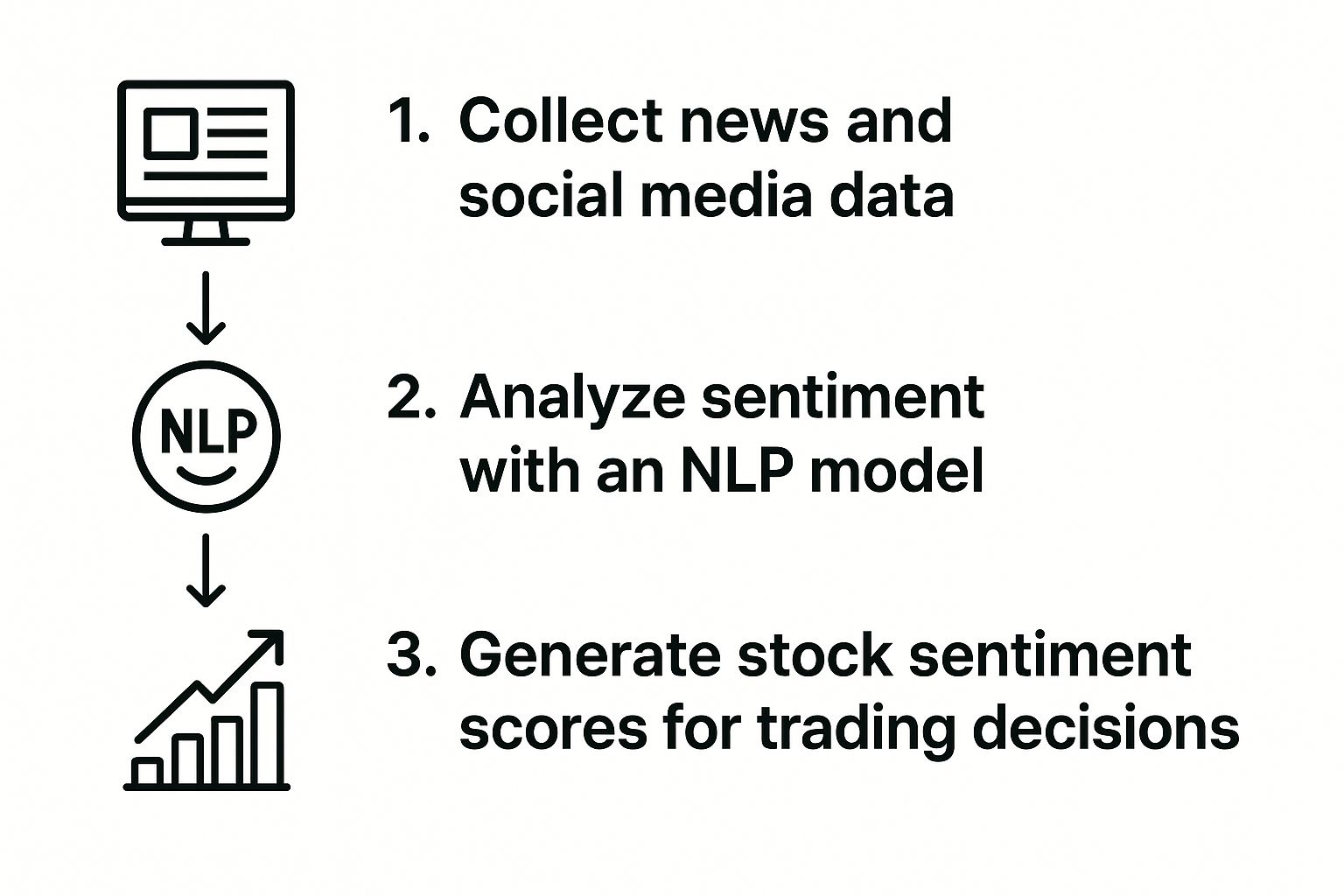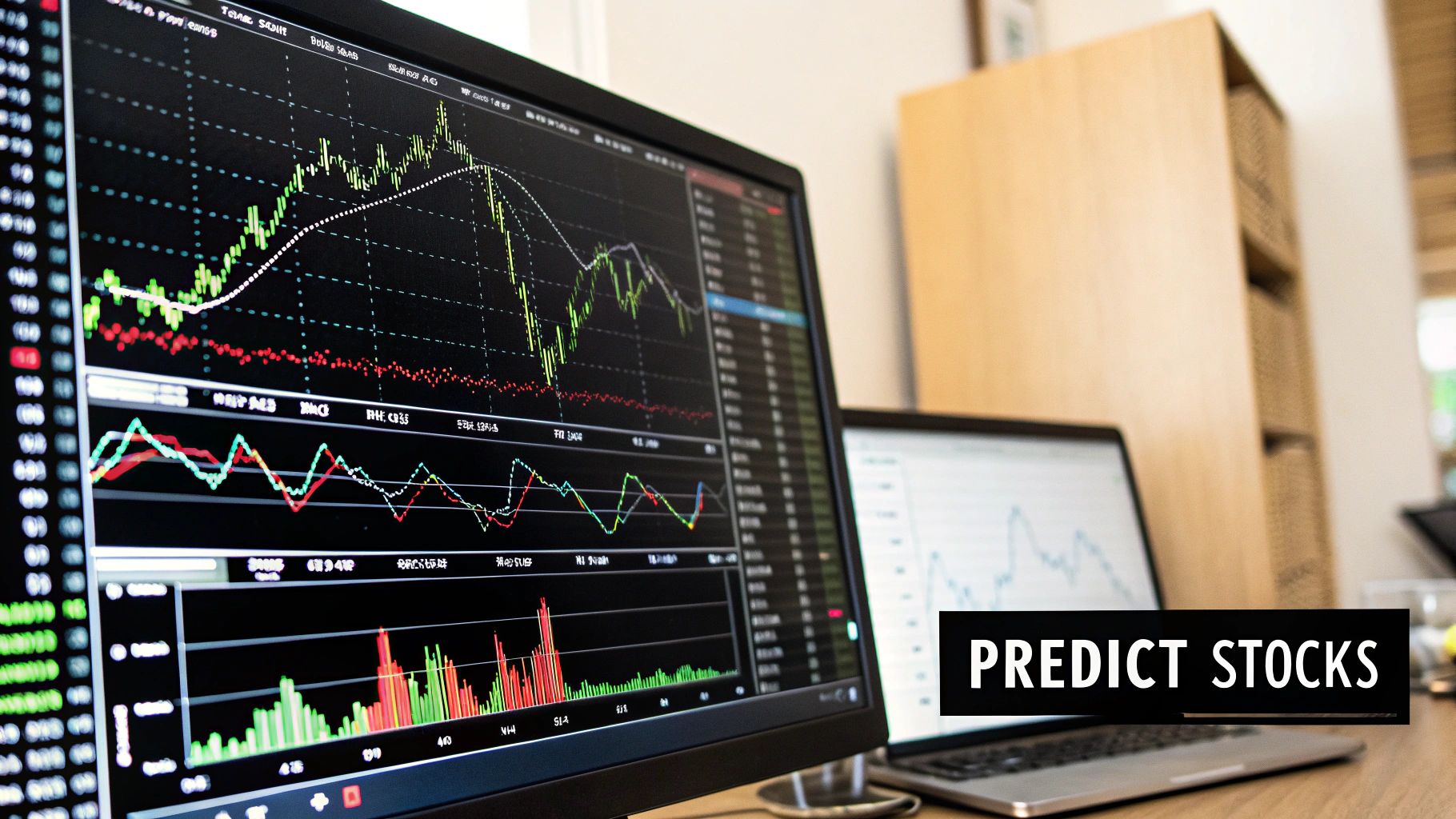Ever feel like the stock market has a mind of its own? Like there's a collective mood or "vibe" that drives prices just as much as any earnings report?
That's exactly what stock sentiment analysis is all about. It’s a method that listens in on the massive, ongoing conversation happening online to figure out if the general feeling about a stock is positive, negative, or just plain neutral. It goes beyond the cold, hard numbers on a balance sheet to tap into the human side of the market.
What Is Stock Sentiment Analysis, Really?

Think of it this way. Traditional stock analysis—poring over P/E ratios and cash flow statements—is like reading a company's official resume. It gives you the facts, the history, and the qualifications. All essential stuff.
But sentiment analysis? That's like being a fly on the wall in thousands of conversations at once. It’s listening to the buzz in the office, hearing what customers are really saying on social media, and catching the whispers from industry experts at a conference. It captures the story and the emotion behind a stock, which can often be a powerful predictor of where the price is headed.
This modern approach uses powerful algorithms to scan and interpret a staggering amount of text from all corners of the internet, including:
- Social media feeds on X (formerly Twitter) and Reddit
- Major financial news outlets
- Company press releases and announcements
- Niche investor forums and blogs
By turning this "digital chatter" into a measurable score, you can spot opportunities or risks that others might miss. A sudden explosion of positive talk after a new product reveal could be a buy signal before the rest of the market catches on. On the flip side, a growing tide of negative comments might be your early warning to take a closer look at a stock you own.
To see how this works in practice, you can explore how to use market sentiment analysis for trading in our other guide.
To quickly grasp the key ideas, here’s a simple breakdown of what stock sentiment analysis involves.
Stock Sentiment Analysis At a Glance
| Component | Description | Example |
|---|---|---|
| What It Is | A method of gauging the market's emotional tone toward a specific stock. | Is the online chatter about Tesla ($TSLA) overwhelmingly positive after its latest AI Day? |
| What It Measures | The overall feeling (positive, negative, neutral) from public online data. | A sentiment score of +0.8 (on a -1 to +1 scale) indicates very positive sentiment. |
| Why It's Important | It can provide early signals of potential price movements before they happen. | A spike in negative sentiment might precede a stock price drop, giving you time to react. |
This table shows how sentiment analysis adds a new, emotional dimension to your trading toolkit, helping you see beyond the numbers.
The More You Hear, The Clearer The Picture
One of the golden rules of sentiment analysis is that volume matters. A lot. The more data you can feed the machine, the more reliable the insights become. It’s the difference between hearing one person's opinion and listening to a stadium full of people. The noise from a few outliers gets drowned out, and a true consensus emerges.
The numbers back this up. One fascinating study showed that models analyzing 20,000 tweets about major U.S. stocks could predict price direction with 85% accuracy. That’s a huge leap from the 60% accuracy they got with a smaller sample of just 3,200 tweets.
This really drives home the point: the more conversations the algorithm can "hear," the more trustworthy its conclusions are.
What’s more, the same study found that blending public sentiment with traditional financial data improved forecast accuracy by 20% compared to using financial models on their own. It’s powerful proof that what people say and feel online has a direct and measurable impact on stock prices. You can dig into the full study and its findings over at research.aimultiple.com.
How AI Turns Online Chatter into Market Signals
So, how does a computer figure out the sarcasm in a trader's tweet or the optimism in a CEO's press release? The magic isn't really magic at all—it’s a powerful combination of Artificial Intelligence (AI) and a specific field called Natural Language Processing (NLP).
Think of NLP as the engine that lets machines read, understand, and interpret human language in all its messy, informal glory.
This whole process is about turning that chaotic online chatter into clean, measurable data you can track just like a stock price. We're not just counting "good" or "bad" words here. Modern sentiment analysis for stocks is way more sophisticated. It’s all about getting the context right, because that’s the only way to generate market signals you can actually trust.
The Core Analytical Concepts
At its heart, the AI model is trained to look for two critical things in any piece of text:
- Polarity: This one’s pretty straightforward. It just asks, "Is the language here positive, negative, or neutral?" Words like "soared," "innovative," and "breakthrough" scream positive polarity. On the flip side, terms like "plummeted," "disappointing," and "failure" clearly signal negative polarity.
- Subjectivity: This is where things get a little more advanced, but it's absolutely crucial. The model has to figure out if a sentence is stating a fact or expressing an opinion. A news headline like, "Company X acquires Company Y," is just a fact—it's neutral and objective. But a tweet saying, "Company X's acquisition of Company Y is a brilliant move!" is pure opinion. That’s subjective, and it’s packed with sentiment.
By weighing both polarity and subjectivity, the AI can filter out the noise and zero in on the opinions that genuinely reflect the market's mood.
This graphic gives you a high-level look at how raw data from the internet gets refined into a real trading insight.

As you can see, it's a simple but powerful flow: gather huge amounts of public information, let an NLP model analyze it, and distill it all down into sentiment scores that can guide your next move.
From Words to a Score
The end product of all this work is a sentiment score. It's a simple number, usually on a scale from -1 (extremely negative) to +1 (extremely positive), with 0 being neutral ground.
For instance, a news article that gets a score of +0.7 is glowing with optimism. But if a flood of social media posts averages out to -0.5, that’s a big red flag signaling some serious bearish feelings.
These scores aren't static. They're pulled together from thousands of sources in real time, giving you a constantly updated pulse on the market’s collective attitude toward a stock. As a trader, you can watch these sentiment scores ebb and flow, using them as a leading indicator to spot potential shifts in price and momentum—often before they even show up on the charts.
Finding Reliable Data Sources for Sentiment Analysis

The accuracy of sentiment analysis for stocks lives and dies by the quality of its data. It's a classic case of "garbage in, garbage out." Relying on a single, biased source is a recipe for disaster, as not all online chatter holds the same weight. A solid strategy involves listening to many different conversations at once to build a complete picture of market opinion.
Think of yourself as a detective piecing together a complex case. You wouldn't close the investigation based on one witness's testimony, would you? Of course not. You’d collect evidence from every possible angle—interviews, forensic reports, background checks—until the truth becomes clear. In the same way, traders need to pull insights from multiple data streams to get a nuanced view of investor sentiment.
The best sentiment analysis models tap into a diverse ecosystem of sources, each with its own quirks, strengths, and blind spots. Let's break down the main places to look.
The Real-Time Social Pulse
Social media platforms are the raw, unfiltered heartbeat of the market. They give you a front-row seat to instant reactions as news breaks, earnings are announced, and prices move, offering a powerful measure of collective emotion.
- X (formerly Twitter): This is where you’ll find a constant flow of opinions from traders, journalists, and everyday investors. Its lightning-fast pace is perfect for catching sudden shifts in mood.
- Reddit (e.g., r/wallstreetbets, r/stocks): These communities offer a direct window into the minds of dedicated retail investors. The discussions here can uncover grassroots trends and high-conviction plays long before they hit the mainstream.
But be warned: this raw data is messy. You’ll have to contend with bots, spam, and emotionally charged language that can easily trip up an algorithm.
Structured News and Official Releases
On the other end of the spectrum is the world of financial news and corporate communications. Unlike the wild west of social media, these sources provide structured, formal language and have long been the foundation of market information.
This includes everything from official press releases and SEC filings to articles from established financial news outlets. While the language is less emotional, the specific tone and word choice can still hint at underlying optimism or concern. The biggest downside here is the time lag; by the time news is officially published, the market may have already priced it in.
Focused Investor Forums
Specialized platforms like Stocktwits offer a nice middle ground. They blend the real-time energy of social media with a laser focus on financial markets, creating a high-signal environment where the noise is filtered out. The conversations are often more detailed and on-topic than what you'd find on broader platforms.
By weaving these different threads together, you create a much more robust and reliable sentiment signal. This blended approach helps you see the full spectrum of market psychology, from fleeting gut reactions to carefully considered analysis. For a deeper look at how market psychology is measured, check out our trader's guide to the Fear and Greed Index.
Of course. Here is the rewritten section, crafted to sound like it was written by an experienced human expert, following all your specified requirements.
Putting Sentiment Analysis into Action in Your Trades
Alright, so you get the theory behind sentiment analysis for stocks. But let's be honest, theory doesn't pay the bills. The real question is how to turn all this data into smarter, more profitable trades. This is where we move past the cool charts and into your actual trading workflow.
First thing's first: sentiment analysis isn't a magic crystal ball. If you trade on sentiment scores alone, you're going to have a bad time. Its true power comes from layering it on top of your existing technical and fundamental analysis. It helps you answer that nagging question: "My chart looks bullish, but does the rest of the market agree with me?"
Confirming Your Technical Signals
We all use technical indicators—the RSI, moving averages, you name it. They're the bread and butter of trading. But we also know they can throw off false signals. A sudden swing in market mood can be the one thing that tells you whether a technical pattern is the real deal or just noise.
- Going Long with Confidence: Picture this: a stock finally punches through its 50-day moving average. That's a classic buy signal. Now, what if you check the sentiment data and see a massive spike in positive chatter on social media and in the news? That's your confirmation. It tells you the crowd is getting behind this move, giving you much more conviction to open that long position.
- Dodging a Bearish Trap: On the flip side, imagine a stock is deep in "oversold" territory on the RSI (below 30). Your gut might say a bounce is coming. But if sentiment analysis shows a growing storm of negative comments—maybe a nasty rumor about a product flaw is spreading—that’s a huge red flag. It’s a warning that the downward pressure is real and that "oversold" could easily become more oversold.
Think of sentiment analysis as your co-pilot. Your technicals are the instruments on your dashboard—they tell you your speed and altitude. But sentiment is the voice from air traffic control, giving you the bigger picture of what's happening outside your cockpit. It confirms if the skies are clear ahead or if you're flying straight into turbulence.
Spotting Trend Reversals Before the Crowd
Here's where things get really interesting. One of the most powerful uses for sentiment is as an early warning system. Very often, a shift in public opinion happens before the price fully catches up. By keeping an ear to the digital ground, you can catch these changes as they're just starting to bubble up.
Let's say a company rolls out a highly anticipated product. The initial price action is pretty quiet, maybe even dips a little. But you notice sentiment scores are starting to climb fast as genuinely positive reviews and user experiences start flooding in. This wave of good vibes could be the first sign of an upcoming rally, giving you a chance to get in before the rest of the market piles on.
The reverse is just as powerful. A stock has been on a tear, hitting new highs. It releases earnings, and the headline numbers look fine. But sentiment tools pick up on something else: widespread disappointment with the CEO's vague guidance on the earnings call. That subtle, negative turn in the conversation is your heads-up that the bullish momentum might be running out of steam. It’s your cue to tighten your stop-loss or maybe even cash in some profits.
A Powerful Tool for Managing Your Risk
Beyond just finding good entries and exits, sentiment analysis is a crucial part of managing your risk. If you're holding a stock and suddenly see an unexplained nosedive in its sentiment score, that’s your signal to start asking questions—immediately. It's an alert system that can draw your attention to a problem long before it hits the front page of the Wall Street Journal.
By making a habit of checking the sentiment on your positions, you can:
- Uncover Hidden Dangers: Find those grassroots complaints or negative stories that haven't made it to the mainstream media yet.
- Avoid "Catching a Falling Knife": If a stock is tanking, a quick sentiment check can save you. If the chatter is overwhelmingly negative, you know you’d be fighting a tidal wave of selling pressure.
- Gauge Reactions in Real-Time: Instantly see how the market really feels about an earnings report or a big announcement, cutting right through the knee-jerk price volatility.
Choosing The Right Sentiment Analysis Tools

The great news? You don’t need a data science degree to read the market’s mood. A whole ecosystem of tools has sprung up to put powerful sentiment data right at your fingertips, with options for every budget and trading style.
Figuring out which one is right for you is a bit like choosing a car. If you’re just commuting, a reliable sedan does the trick. But if you’re a professional racer, you need a high-performance machine with every possible metric on display. It's the same with trading—your needs dictate the tool.
Platforms For Every Type of Trader
The market for sentiment analysis for stocks is packed with options that fall into a few main buckets. If you need a refresher on the basics, our guide on what social sentiment is is a great place to start.
- Community-Driven Platforms: Think of places like Stocktwits. Sentiment here bubbles up organically from a massive community of retail traders. It’s fantastic for getting a raw, real-time pulse on what the crowd is thinking.
- Specialized Sentiment Providers: Companies like Sentifi live and breathe this stuff. They are dedicated to crunching sentiment from millions of sources, offering more refined analytics and deeper insights than you'd get from a social feed alone.
- Integrated Brokerage Tools: More and more brokerages are building sentiment indicators directly into their trading platforms. This is all about convenience, keeping your research and your trades in one tidy place.
- Professional Terminals: These are the big guns, like the Bloomberg Terminal. They're built for institutional traders and hedge funds, providing the most granular data imaginable.
The trick is to find the right tool for your specific strategy. A long-term, buy-and-hold investor might be perfectly happy with a weekly sentiment report. A day trader, on the other hand, will want minute-by-minute updates to pounce on sudden shifts.
Choosing a tool isn't about finding the "best" one overall, but the best one for you. The goal is to find a platform that provides actionable data in a format you understand, without overwhelming you with features you'll never use.
Comparing Types of Sentiment Analysis Tools
With so many options, it helps to see them side-by-side. This table breaks down the main categories to help you match a tool to your trading style and budget.
| Tool Type | Best For | Typical Cost | Example Platforms |
|---|---|---|---|
| Community-Driven | Gauging retail trader buzz and real-time reactions | Free to Low-Cost | Stocktwits |
| Specialized Providers | Deeper, AI-powered analysis from news and social media | Moderate (Subscription) | Sentifi, Fear & Greed Tracker |
| Integrated Brokers | Convenience and all-in-one research and trading | Included with brokerage account | E*TRADE, Fidelity |
| Professional Terminals | Institutional-grade data and advanced analytics | Very High (Thousands/month) | Bloomberg Terminal, Refinitiv Eikon |
Ultimately, the right tool is the one that gives you an edge. Whether it’s a free community platform or a sophisticated paid service, the key is to integrate its insights into your decision-making process.
Of course. Here is the rewritten section, crafted to sound like it was written by an experienced human expert, following all the specified requirements.
Don’t Get Burned: Common Pitfalls and How to Avoid Them
Let's be clear: stock sentiment analysis is a powerful tool, but it's not a crystal ball. Thinking of it as a magic bullet is the fastest way to lose money. To use it right, you have to first understand its blind spots.
One of the biggest hurdles is that AI still struggles with us. It can miss the sarcasm in a tweet or get tangled up in complex financial jargon, spitting out a sentiment score that's just plain wrong. The digital world is also incredibly noisy. Armies of bots and spam accounts can create fake hype or panic, making an algorithm see a trend that a human would instantly dismiss.
This is exactly why you, the trader, are still in the driver's seat. Treat sentiment data as an advisor, not the final word.
Best Practices for Trading with Sentiment Data
To sidestep these traps, you need to weave sentiment analysis into a solid, disciplined trading plan. It's a fantastic consultant, but it shouldn't be the CEO making the final buy or sell decision.
Here are a few ground rules I always stick to:
- Confirm, Don't Just Act: Never, ever enter a trade based on a sentiment score alone. Use it to confirm a signal you've already found through your own charting or fundamental research. See a bullish chart pattern forming? If it’s backed by a wave of positive sentiment, your confidence in that trade should go way up.
- Layer Your Intel: The best traders are masters at combining different sources of information. They lay sentiment data over their technical indicators (like RSI or moving averages) and fundamentals (like P/E ratios and earnings reports). A single data point can be misleading, but a complete picture is much more reliable.
- Backtest, Backtest, Backtest: Before you risk a single real dollar, run your sentiment-based strategy through historical data. How would it have performed last year? During the last market dip? Backtesting is your reality check—it shows you what works, what doesn't, and where your strategy's weaknesses lie.
A great real-world example of this kind of data is the AAII Investor Sentiment Survey, which has been tracking how individual investors feel for decades.
Look at this chart. It shows that while bullishness has dipped recently, it’s remained above its historical average for a whopping 37 of the last 38 weeks. That tells a story of persistent optimism among retail investors. These metrics swing back and forth like a pendulum and can give you an early warning about potential market tops or bottoms. You can dig into how the pros use these investor sentiment survey insights from aaii.com.
The biggest mistake you can make is confusing correlation with causation. A surge in negative chatter doesn't cause a stock to drop; it reflects an underlying fear or problem that might trigger a sell-off. Your job is to dig deeper and find the "why" behind the numbers.
Still Have Questions? Let's Clear a Few Things Up
When you start digging into stock sentiment analysis, a few common questions always pop up. Let's tackle them head-on so you can see exactly where it fits into a modern trading strategy.
Is Sentiment Analysis a Reliable Stock Predictor?
This is the big one, isn't it? The short answer: no, not by itself. Sentiment analysis isn't a crystal ball that spits out perfect stock predictions. Anyone who tells you otherwise is selling something.
Instead, think of it as a powerful supplementary tool. Its real magic happens when you blend its insights with your trusty technical and fundamental analysis. A sudden spike in positive chatter can be the extra confirmation you need for a bullish chart pattern. On the flip side, a wave of negative buzz can be an early warning flare, telling you to take a second look at a stock that otherwise seems solid on paper. It adds that missing layer of market psychology, making your decisions far more well-rounded.
Can I Do My Own Stock Sentiment Analysis?
You absolutely can, but it's a serious undertaking. If you want to build your own models from the ground up, you'll need a solid grasp of programming (like Python), data science, and Natural Language Processing (NLP). It means getting your hands dirty with gathering, cleaning, and training a model on massive datasets.
For most traders, though, there's a much more practical route: using a platform that’s already done the heavy lifting. Tools like Fear Greed Tracker provide ready-to-use sentiment scores and analytics. This frees you up to focus on what you do best—developing your strategy, not becoming a data engineer.
How Is This Different from Technical Analysis?
They’re two completely different sides of the same coin.
Technical analysis is all about the "what." It's the art of studying historical price charts and trading volumes to spot patterns and forecast future moves. It lives in a world of support, resistance, moving averages, and MACD.
Sentiment analysis is about the "why." It digs into market psychology—the collective mood, opinions, and raw emotion of investors—to understand the forces driving the price action.
While technical analysis charts the market's behavior, sentiment analysis tries to read its mind.
Ready to move beyond basic charts and tap into the real mood of the market? Fear Greed Tracker delivers real-time sentiment scores on over 50,000 assets, helping you turn market emotion into a strategic edge. Start making data-driven decisions today.
